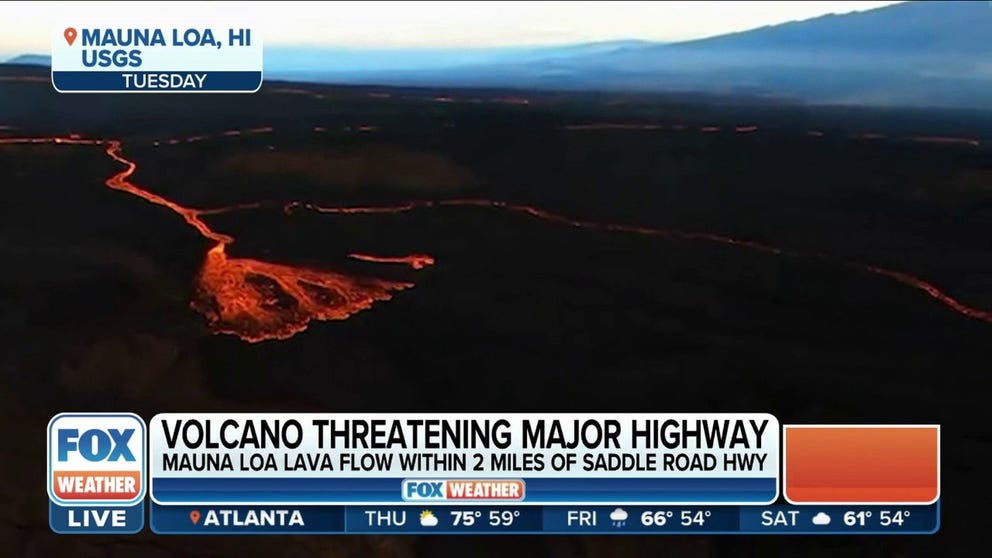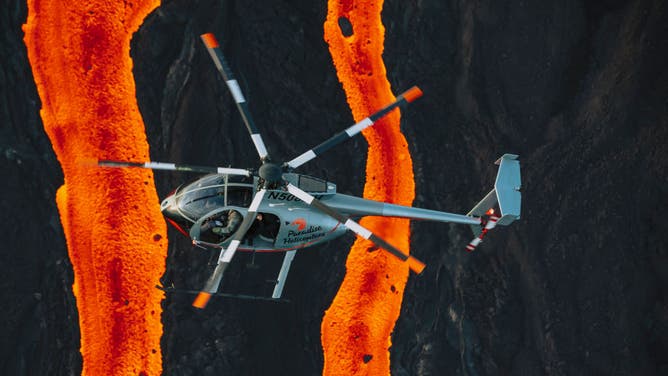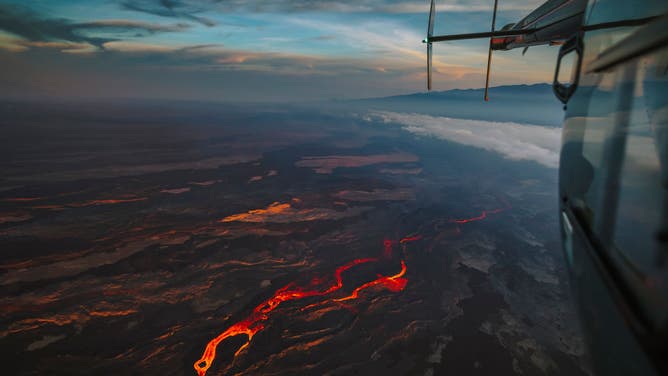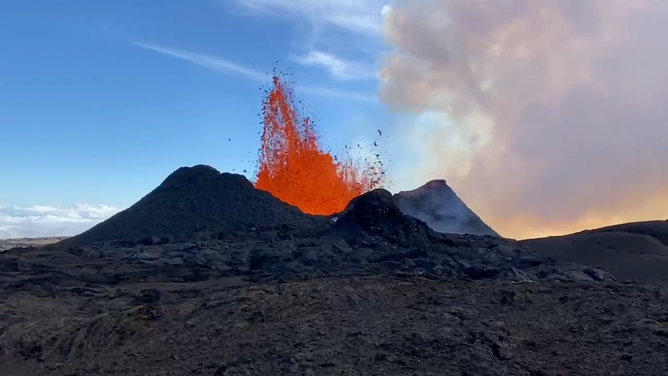Mauna Loa volcano lava slows to crawl toward major Hawaii highway
The Hawaii Volcano Observatory reports the lava flow from Mauna Loa's fissure 3 is now 1.7 miles from Saddle Road but has slowed from 40 feet per hour down to 20 feet.
Mauna loa lava flow crawls at 20 feet per hour toward Saddle Road
The Hawaii National Guard was activated as Mauna Loa volcano continues to erupt for the second week. According to the USGS, the lava flow has slowed from 40 feet per hour to 20 feet per hour and only one fissure continues to feed the lava downslope toward Saddle Road.
HILO, Hawaii – Nearly two weeks after it began, Mauna Loa's volcanic eruption continues to draw spectators worldwide to see the volcano's historic display.
The U.S. Geological Survey Hawaiian Volcano Observatory has been monitoring all activity since the Mauna Loa volcano began erupting on Nov. 27 for the first time in 38 years.
In the latest update from the HVO, officials say the lava flow has advanced very little since Wednesday morning. The Big Island remains under a Volcano Warning.
Meanwhile, the volcano continues to emit about 120,000 tonnes of sulfur dioxide per day. The elevated level of volcanic gas continues to rise high into the atmosphere and blow vog, also known as volcanic air pollution, downwind.
RARE PACIFIC SEABIRD ESCAPES ERUPTION OF HAWAII’S LARGEST VOLCANO
The only active zone of the volcano remains in the Northeast Rift, sending lava flowing toward Hilo.
How close is the lava flow to Saddle Road?
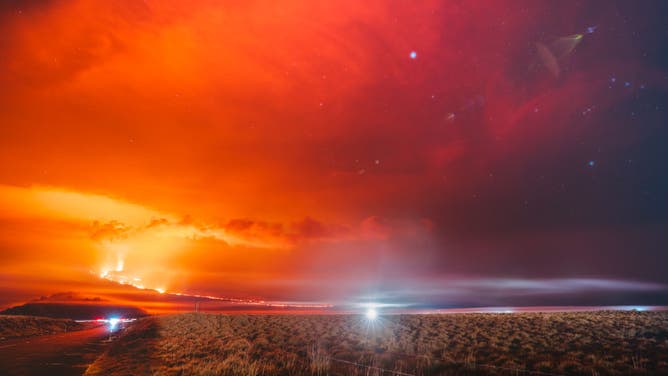
Lava fissures flow downslope from the north flank of Mauna Loa Volcano on December 5, 2022 in Hilo, Hawaii. For the first time in almost 40 years, the biggest active volcano in the world erupted prompting an emergency response on the Big Island. (Photo by Andrew Richard Hara/Getty Images)
(Getty Images)
Mauna Loa is not threatening any of the Big Island's 200,000 residents or infrastructure, according to the Hawaii County Civil Defense Agency. However, officials have been keeping a close eye on the lava flow creeping closer to a major highway on the Big Island since the eruption began.
Saddle Road, or Hawaii Route 200, runs more than 50 miles west-to-east across the island and serves as a crucial thoroughfare between Hilo and Kona.
Only one active fissure, fissure 3, from the Northeast Rift Zone of Mauna Loa continues to erupt, but the supply of lava flow has reduced, according to the USGS.
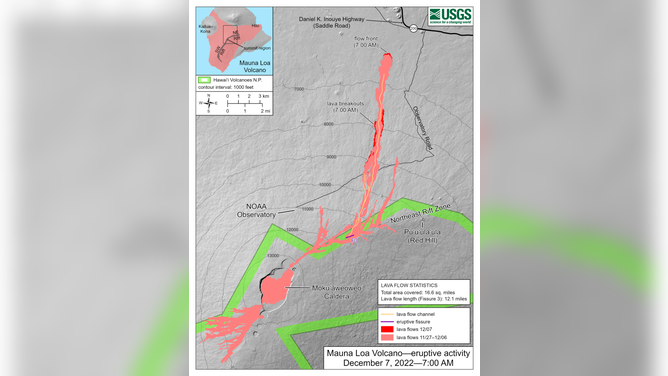
The latest Mauna Loa eruption map showing the active lava flow from fissure 3 approaching Saddle Road. (Image: USGS)
Earlier this week, the lava was moving at 40 feet per hour but slowed to 20 feet per hour by Wednesday and stalled out by Thursday. This crawling lava is inching toward Saddle Road.
HAWAII'S MAUNA LOA VOLCANO SPEWS 'LAVA FOUNTAIN' OF LIQUID ROCK INTO AIR AS LAVA FLOWS SLOW
"The lava flow is now inactive for most of its lower length, but the flow front may appear to advance a little as it settles," according to the USGS.
On Thursday, the USGS said the lava is about 1.7 miles from Saddle Road. The highway remains open in both directions, but areas adjacent to the lava flow along Old Saddle Road are closed.
It is illegal to trespass onto the lava field due to the highly dangerous lava around 2,000 degrees and unexploded ordnances lurking off Saddle Road from a military training area.
Hawaii activated the National Guard to help manage crowds who have flocked to the Big Island to witness the historic eruption.
Why has the lava flow slowed down?
According to the HVO, the lava flow rates may change significantly in the coming days and weeks.
Many factors contribute to the timing of flow advances, which can quickly change over hours or even days, making it difficult to predict the coming impacts from Mauna Loa.
"Lava flows advance more slowly, spread out, and inflate on the flat ground between Mauna Loa and Mauna Kea," according to the HVO. "Individual lobes may advance quickly and then stall. Additional breakouts may occur if lava channels get blocked upslope."
Mauna Loa eruption: See all of the most incredible volcano footage
The eruption of Mauna Loa, the world’s largest active volcano, began on November 27, after remaining quiet for nearly 40 years.
WHEN WILL MAUNA LOA STOP ERUPTING?
This is the first time Mauna Loa has actively erupted since 1984.
Volcanologists don't know how long the eruption will continue. It's not an exact science trying to predict when a volcano will stop. During the last eruption, Mauna Loa spewed lava and gas for three weeks before the eruption was officially declared over.
Mauna Loa has erupted 33 times since its first well-documented eruption in 1843, according to the USGS Hawaiian Volcano Observatory.
